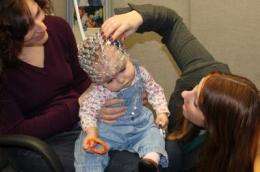Research suggests infants begin to learn about race in the first year

Results of a new study reported recently by psychology researcher Lisa Scott and colleagues at the University of Massachusetts Amherst confirm that although infants are born with equal abilities to tell apart people within multiple races, by age 9 months they are better at recognizing faces and emotional expressions of people within groups they interact with most.
The researchers found that by 9 months, infants show a decline in their ability to tell apart two faces within another race and to accurately match emotional sounds with emotional expressions of different-race individuals. This is the first investigation of this effect in infancy and supports other studies suggesting that emotion recognition is less accurate for other-race faces than own-race faces. Scott's paper was singled out for special mention as the "Editor's Choice" article in the May issue of Developmental Science.
This research suggests that throughout the first year of life, babies are developing highly specialized perceptual abilities in response to important people in their environment, such as family members. This focus of attention to familiar groups of people compared to unfamiliar groups is hypothesized to be the root of later difficulties some adults have in identifying and recognizing faces of other races.
This is similar to how babies learn language. Early in infancy babies do not know yet which sounds are meaningful in their native language, so they treat all sounds similarly. But as they learn the language spoken around them, their ability to tell apart sounds within other languages declines and their ability to differentiate sounds within their native language improves.
Scott says, "In addition to providing information critical for understanding how infants learn about the surrounding environment, the results of this research may serve as a guide for early education and interventions designed to reduce later racial prejudice and stereotyping" Scott states. "These results suggest that biases in face recognition and perception begin in preverbal infants, well before concepts about race are formed. It is important for us to understand the nature of these biases in order to reduce or eliminate them."
For this study, each infant came to the lab with a parent for a one-hour session that included showing infants pictures of faces and having them listen to sounds while their looking time and brain activity were recorded. Forty-eight Caucasian infants with little to no previous experience with African-American or black individuals participated in this study.
Infants completed two tasks. The first was designed to assess their ability to tell the difference between two faces within their own race and two faces within another, unfamiliar, race. For the second task, a net of recording sensors was placed on the infant's head to record brain activity while they viewed own-race and other-race emotion faces (happy, sad) that either matched or did not match a corresponding emotion sound (laughing, crying).
Consistent with previous reports, 5-month-old infants were found to equally tell apart faces from both races, whereas 9-month-old infants were better at telling apart two faces within their own race, Scott and colleagues report.
Further, measures of brain activity revealed differential neural processing of own-race compared to other-race emotional faces at 9 months. However, 5-month olds exhibited similar processing for both own- and other-race faces. In addition, infants were found to shift their processing of face-related emotion information from neural regions in the front of the brain to neural regions in the back of the brain from 5 to 9 months of age. This shift in neural processing helps researchers understand how the brain develops in response to experience during the first year of life.















